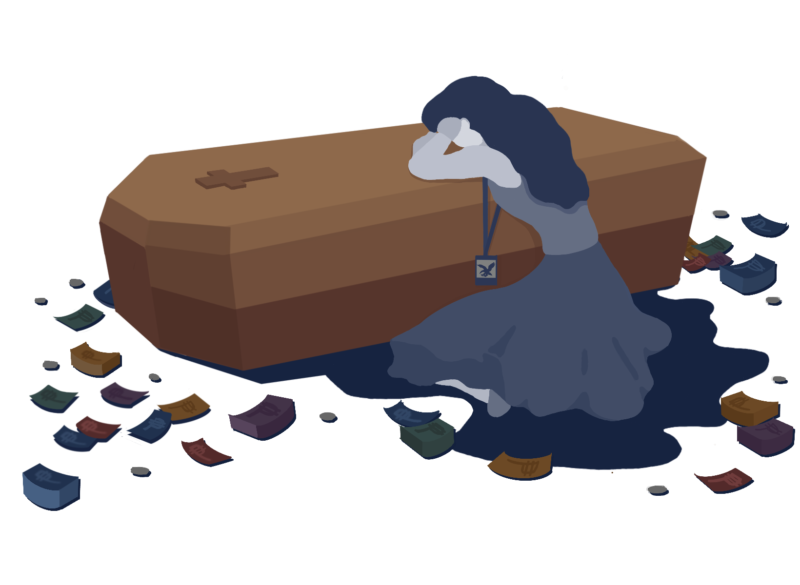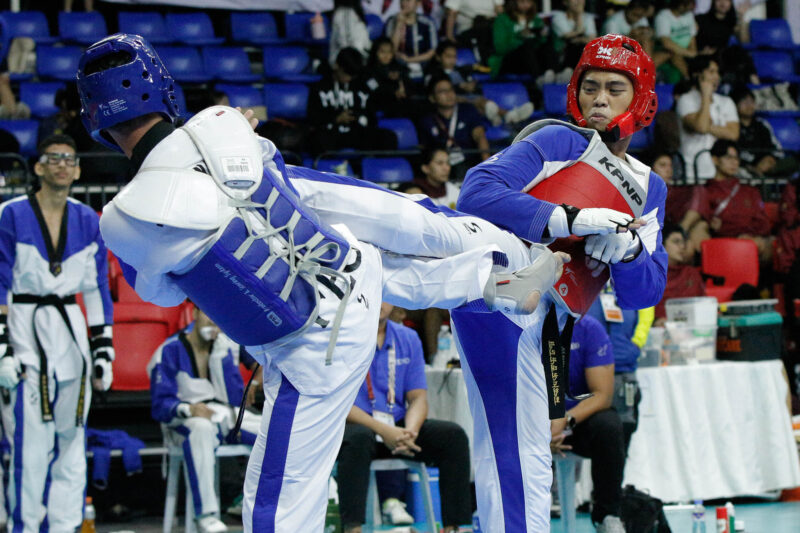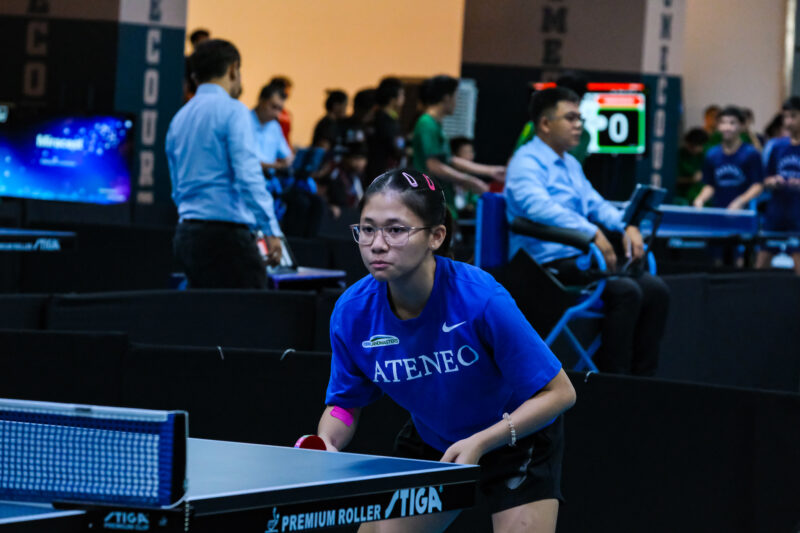The Blue Eagle is one of the most well recognized brands in Philippine collegiate sports. It is a symbol that is often considered synonymous with the Ateneo itself and its imagery has diffused into milieus both within and outside the university. Its popularity is driven both by school spirit and the narratives that surround university sports, now most notably the Ateneo Men’s Basketball and Women’s Volleyball teams.
In the more recent years, however, the brand has taken a more commercialized character. Many companies pay the university licensing fees and royalties to use the Ateneo name in their products. More prominent athletes often acquire lucrative endorsement deals for major brands across the country. Chris Tiu, one of the most famous basketball players and a graduate of an honors course, was touted as the perfect example of an “ideal Atenean.”
A brand sustained by college athletics can impact the school’s reputation and marketability. However, some would argue that this sort of branding has subtle implications on the priorities imposed on athletics programs and may place the involved parties in an ethical grey area.
Sports as a marketing tool
The use of sports as a marketing tool is not a new idea. For much of the past century, sport and advertising have gone hand-in-hand, with many of history’s most successful athletes—think Jordan, LeBron, and Messi—attracting the eye of sponsors who sought association with the athletes’ fame and success.
Such practices are, however, not limited to big corporations and professional sports teams. Even schools have gotten in on the act, utilizing the success of their sports programs as a marketing tool both to attract funding through sponsorships and to boost student recruitment. The Ivy League – often used to refer to several elite universities in the American northeast, Harvard and Yale among them – was a term that originated from the National Collegiate Athletic Association (NCAA) athletic conference that the schools participated in and the intense rivalries that arose among them. Nowadays, the name is more widely recognized as a coveted status symbol many can only aspire for.
The University Athletic Association of the Philippines (UAAP), one of the top governing bodies for collegiate sports in the country, is no stranger to this phenomenon. There is an abundance of sponsorship deals spread across the universities’ teams, as well as with UAAP itself, such as those with Nike, PSBank, and Manulife, as well as the exclusive broadcasting deals given to ABS-CBN and its affiliates.
However, more than just the commercial aspect, the use of sports for student recruitment is not lost upon the schools. The UAAP’s massive following and wide reach provides unparalleled exposure to the participating universities.
University Athletics Director Emmanuel Fernandez argues that people’s natural tendency is to gravitate toward what they know, hence the value of name recognition. “I know for most sports programs like [those of] FEU [and] NU, they really use their participation in sports to get more applicants into their university. So they use the UAAP [itself] to attract students, to introduce their school to prospective students, especially from the provinces. So if they ask ‘where do you [want to] go?’ [the answer will be] I [want to] go to FEU, because I see them on TV,’” he says.
The Ateneo brand
The Blue Eagle was formally adopted as the university’s mascot in 1938. Officially, it refers to the men’s basketball team that plays in the UAAP and variations of the name have been used in other divisions such as the UAAP juniors (Blue Eaglets) and women’s division (Lady Eagles). The captain of the basketball team is commonly referred to as the “King Eagle,” a reference to the school’s fight song Blue Eagle, the King. The first time this name was used in mainstream media was during the 1957-1958 back to back NCAA championships, with Edgardo Ocampo as team captain.
Many companies, ranging from multinational sportswear giants such as Nike to student-founded retail brand GetBlued have commercialized the Ateneo brand. These companies engage in licensing agreements and pay royalties for permission to use trademarked names such as the Blue Eagle, Fabilioh, and Heartstrong, as well as the school’s visual trademarks. Aside from this, sports teams also have corporate sponsors that provide gear such as uniforms and shoes. However, the school only officially handles partnerships up to a team level—sponsorships of individual players are between the player and the sponsor itself.
Kirk Damasco (BS MGT ‘08), Ateneo alumnus and one of the founders of GetBlued, says that the strength of the brand stems from the strength of the institution it represents. “The Ateneo brand is a strong brand precisely because it has a long history to it, it has achieved many things, became a witness to many things, and it is generally associated with excellence and magis as we call it,” he says.
Fernandez says that the school’s athletic performance may play a vital part in student recruitment. Assuming a positive correlation between athletic performance and the number of applicants to the Ateneo, he argues, implies bigger chances of getting better students. However, he also concedes that we have yet to see hard data to confirm this correlation.
For student manager Patricia Punsalan, branding does play a big role in attracting students. “Each school has its own brand, which most, if not all students hold great reverence to. Looking particularly at the Ateneo, I have seen first-hand how drawn high school students are to the way the school presents itself,” she says. “It’s the entire Ateneo experience that draws people in.”
In any case, what is certain is that when the school’s athletic performance is on the up, so are sales. Damasco links Ateneo’s athletic performance to school spirit and pride as the main driver of sales, and pointed out that one of the high points for GetBlued was during the five-peat era of 2008-2012. “If the pride for the school is overwhelming because of championships, then sales are good. But if the pride for the school is kind of sakto lang, then di masyado,” he says.
However, sports isn’t everything. In his paper titled “Masculinity, Patronage Politics, and the Feminization of School Spirit in the Ateneo-La Salle UAAP Rivalry,” English department instructor Miguel Lizada writes that while the Ateneo brand is often associated with the sports teams, especially for those not part of the community, the other connotations it brings along also run deeper.
In a follow-up interview, Lizada said, “For members of the academic community, the brand is often tied to everyday culture and uniqueness in pedagogical formation. If you want to know what these are just ask an alumni what they think of Ateneo. They often mention their memorable Humanities classes such as Philosophy and Theology.”
Damasco echoes similar sentiments and asserts that it is important to talk about who is involved, as their perception of what the Ateneo brand is can vary greatly. “The way I see it kasi, people on the outside have different touchpoints with how they come in contact with Ateneo as a brand. Those who are into sports come in contact through sporting activities. Those who are into the academe—through research grants, research fellowships, guest lectures. For those who are in policy, in government, then yung touchpoint nila with the Ateneo brand are Ateneo offices and affiliate student groups and initiatives that do socio-civic activities,” he says.
Ethical issues
Of course, all this brand-building is not without its issues. On the business side of things, the commercialization of the Ateneo brand raises concerns about ethical business practices, namely commodification and profit-seeking—things that fly in the face of Ateneo’s core values as a Catholic institution. While commercialization may seem unavoidable in this day and age, Lizada stresses that we must be careful not to treat it solely as a business. “There is a lot that can happen when you commodify, say, our athletes which is something that happens more frequently these days. Talents of the students are transformed into marketable goods,” he says. “While competition to get the best and the brightest are real, must be careful and ensure that these are not merely economic transactions.”
At the end of the day, the Ateneo is first and foremost a school, and its star athletes are still students. The goal of commercialization here must be to create lasting value for the parties involved and in the case of the Ateneo, it means helping to convince prospective students to come to its side of the fence.
Fernandez sees no major issues with the school’s commercialization activities, but indicates that it is an issue when other parties profit from the brand without the permission of the school. “Bawal pagkitaan ang eskwelahan. Ang eskwelahan lang siguro ang pwedeng kumita sa eskwelahan (It’s wrong to profit off of the school. Only the school should profit from the school),” he says. Fernandez emphasizes that the appropriate royalties must be paid and guidelines must be followed regarding the use of the school’s name and image.
Blue Eagle, the king
The Blue Eagle has certainly come a long way. From simply being the basketball team’s moniker, it’s now come to represent everything the Ateneo stands for – excellence in academics, athletics, character formation, and much, much more. It’s a symbol that students, faculty, and even casual fans can all get behind.
While some may fret at its commercialization, those involved assert that it’s simply another way of creating value for the school through student recruitment and culture formation—profit takes the backseat. As long as this stays true, then there shouldn’t be any reason why the Blue Eagle won’t keep soaring.
Editor’s Note: This article was edited for clarity.







